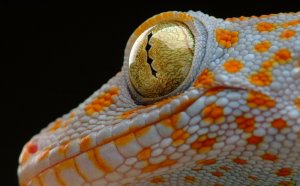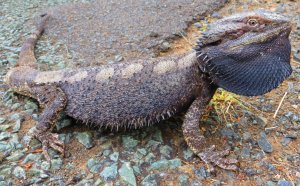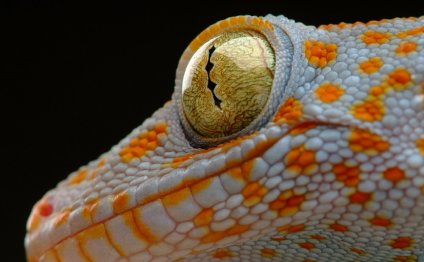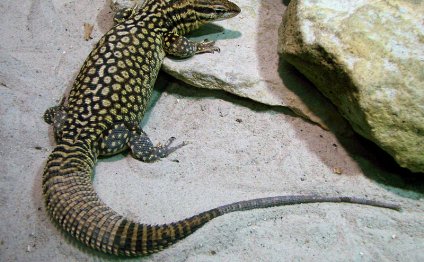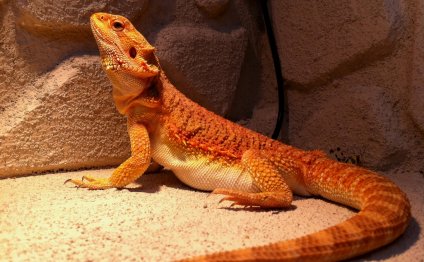
Bearded Dragon Pet store
14-22 inches
CAGE TEMPS:
Warm side - 78-90℉
Basking - 95-100℉
Cool side - 68℉
* If temp falls below 68℉ at night, may need supplemental infrared or ceramic heat for night-time
CAGE HUMIDITY:
Low(desert dweller)
WILD HISTORY:
Bearded Dragons are from the arid, semi-desert regions of Australia. They love to climb, and spend much of their time in bushes and low trees. They also bask on rocks and warm areas in the high sun. Bearded dragons do have distinct puffy beards, which grows larger and darker when the dragon is angered or annoyed.
NORMAL BEHAVIOR & INTERACTION:
Very social & engaging - generally very gregarious. “Beardies” handle well and often seem to actually enjoy being held & petted. By lizard standards, bearded dragons are very social animals. In nature, males become territorial and can engage in ritualized dominance struggles. Females may also have trouble getting along. For this reason, it is easiest for the pet owner to keep only one per enclosure.
Housing male dragons together will create a dominant/submissive hierarchy and will result in one dragon becoming stressed to the point of illness, anorexia, and possibly death. Male dragons also tend to be extremely aggressive toward one another and will fight, sometimes to the death.
Female dragons may be housed together IF there is ample space and food for each dragon. Two to three dragons can live happily in a 75 gallon tank.
Males and females should NOT be housed together, as the male dragons will continually try to mate with the females; leaving the females exhausted, aggravated, and stressed. The female may stop eating and become extremely ill.
NOTE: DO NOT house bearded dragons with other species due to the differences in care, temperatures, and the fact that some species can be highly stressed in the presence of other species.
FEEDING:
Bearded Dragons are omnivorous, which means they eat both meat and vegetables. About 20% of an adult’s diet should be made up of plant matter, the remaining percentage being protein.
VEGETABLES: Dark leafy vegetables such as collard and mustard greens, kale and red tip leaf lettuce are good for a dragon, as are alfalfa pellets, clover, parsley, and broccoli, green beans, peas, squash, grated carrots and sweet potatoes. Spinach and iceberg lettuce should never be fed. Fruits such as figs, kiwi, apples, raspberries, strawberries and melons can also be fed, but should not be given as often. Remember to wash vegetables thoroughly, then cut or shred to make it easier to ingest. Remove any uneaten vegetables before turning the lights off at night.
PROTEIN: Protein sources such as: gut-loaded crickets, mealworms, cockroaches, kingworms, wax worms and pinkie mice dusted with a supplement should also be part of their diet. Wild caught insects should never be fed, since they can carry disease. All insects should be gut loaded (fed a nutritious diet about 24-hours before being offered to your dragon - see our cricket care sheet). Be careful to feed the proper size prey for your dragon’s size. A good rule of thumb is that a cricket should be never be larger than the distance between the lizard's eyes, or the distance from its eyes to its nose. When feeding larger insects to your pet, try to make sure the insects have recently molted, as an insect with a large, hard exoskeleton is difficult to digest and may cause impactions.
LIGHTNING BUGS MUST NEVER BE FED TO A BEARDED DRAGON. THEY ARE POISONOUS.
Adults should be given insects 2-3 times a week, with salads on the rest of the days. Feed as many insects as the lizard can eat in 3-5 minutes. All uneaten insects should be removed from the enclosure as they can bite your dragon and cause injury, especially to the eyes. Some bearded dragon owners find it easier to feed their pet in a separate enclosure, free of bedding and furniture, this way you can be sure your lizard eats all its insects, the prey cannot hide, and the lizard will not pick up any bedding when grabbing prey and mistakenly ingest it along with the prey.
Commercially prepared bearded dragon diets are available, but they should never constitute the whole diet of your lizard. They can be left in the enclosure (on the cool side) in case your pet is hungry between meals.
SHEDDING:
Unlike snakes, lizards shed their skin in patches, not all in one piece. Your pet will become an overall dull color, and the skin over the eyelids may ‘pop’ at a certain point and make your lizard look like a bug-eyed bullfrog. Do not peel off the skin if it is not ready to come off. This can be dangerous and painful. Most lizard species will shed every 4-6 weeks. If the enclosure environment is ideal, the keeper often has no idea that their pet has shed, as it will happen more quickly and the lizard will often eat its own shed skin.
See also:
- Эта сумка для рыбалки через плечо поясная рыболовная очень удобна и практична.
RELATED VIDEO
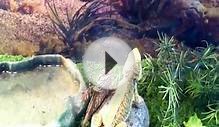
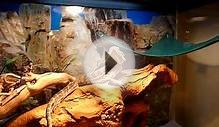
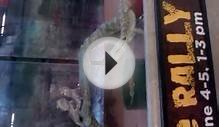
Share this Post
Related posts
Colorful lizard
A very large species of chameleon that is endemic to forests in eastern and northern Madagascar. They reach up to 68 cm (27…
Read MoreBearded Dragon for kids
New to bearded dragons? No problem! This page will go over general bearded dragon information and facts so you will be able…
Read More